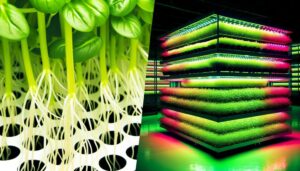Hydroponic Farming What Can You Grow
Hydroponic farming supports the cultivation of various crops such as leafy greens, herbs, fruiting plants, root vegetables, and exotic species. Leafy greens benefit from rapid growth and efficient water use, while herbs thrive in controlled environments, enhancing phytochemical levels.
Fruiting plants grow efficiently with precise nutrient delivery and regulated conditions, improving fruit quality. Root vegetables like carrots and beets exhibit superior nutritional profiles and reduced pest incidence in hydroponics.
Exotic plants, managed with advanced techniques like nutrient film technique (NFT), show increased growth rates and yield. Learn detailed advantages and techniques to achieve the best hydroponic growth across diverse crops.

Key Takeaways
- Leafy greens like lettuce and spinach thrive in hydroponic systems, showing up to 30% higher yields.
- Herbs such as basil and mint benefit from controlled environments, resulting in superior quality and consistency.
- Fruiting plants including tomatoes and peppers grow efficiently with balanced nutrients and regulated conditions.
- Root vegetables like carrots and beets achieve ideal root development and uniform growth in hydroponics.
Leafy Greens

Leafy greens, including varieties such as lettuce, spinach, and kale, are particularly well-suited for hydroponic farming due to their rapid growth rates and relatively low nutrient requirements.
These crops exhibit ideal photosynthetic efficiency in hydroponic systems, benefiting from precise control over nutrient delivery and environmental conditions.
Research indicates that hydroponically grown leafy greens can achieve yield increases of up to 30% compared to traditional soil farming.
In addition, the closed-loop nature of hydroponic systems minimizes water usage by up to 90%, aligning with sustainable agricultural practices.
Moreover, hydroponic setups mitigate pest-related issues and reduce the need for chemical pesticides, promoting healthier produce.
The integration of LED lighting tailored to photosynthetic wavelengths further enhances growth rates and nutritional profiles.
Herbs
Herbs, such as basil, mint, and cilantro, thrive in hydroponic systems due to their adaptability to controlled environments and precise nutrient management.
These aromatic plants benefit from hydroponic cultivation as it allows for meticulous control over pH levels, nutrient concentrations, and light cycles, optimizing growth rates and phytochemical concentrations.
Research indicates that hydroponically grown herbs exhibit superior quality and yield compared to soil-grown counterparts, largely due to the elimination of soil-borne pathogens and pests.
Furthermore, hydroponic systems facilitate year-round production, independent of seasonal variations, thereby ensuring a consistent supply.
The integration of technologies such as automated nutrient delivery and LED lighting further enhances the efficiency and scalability of hydroponic herb farming, making it a viable option for commercial and home growers alike.
Fruiting Plants

Fruiting plants, such as tomatoes, strawberries, and peppers, exhibit remarkable growth and yield potential when cultivated in hydroponic systems due to the controlled nutrient delivery and ideal environmental conditions.
The precision of hydroponic nutrient solutions guarantees balanced macro and micronutrient availability, optimizing plant metabolic processes.
Environmental parameters such as light intensity, photoperiod, temperature, and humidity are meticulously regulated, mitigating stress factors and promoting robust flowering and fruiting.
Data indicates enhanced fruit quality and accelerated growth cycles compared to traditional soil cultivation.
Furthermore, hydroponic systems prevent soil-borne diseases and pests, reducing the need for chemical interventions.
This method supports sustainable agriculture by maximizing space utilization and water efficiency, aligning with the innovative goals of modern horticulture.
Root Vegetables
Root vegetables, including carrots, radishes, and beets, demonstrate significant growth efficiency and quality improvements when cultivated through hydroponic methods, thanks to precise control over nutrient composition and environmental conditions. Hydroponic systems facilitate ideal root development, uniform growth, and enhanced yield. Empirical studies reveal that hydroponically grown root vegetables exhibit superior nutritional profiles and reduced pest incidence compared to traditional soil cultivation. The controlled environment mitigates external stressors, thereby ensuring consistent crop quality and minimizing resource usage.
| Root Vegetable | Hydroponic Advantages |
|---|---|
| Carrots | Uniform shape, higher beta-carotene |
| Radishes | Faster growth cycle, increased crunch |
| Beets | Enhanced pigment concentration, sweeter taste |
| Turnips | Consistent size, improved texture |
| Parsnips | Reduced bitterness, quicker maturation |
This evidence supports hydroponics as a viable, innovative approach to root vegetable production.
Exotic Plants

Exotic plants, such as orchids, bromeliads, and certain tropical ferns, exhibit remarkable adaptability and growth optimization when cultivated in hydroponic systems, leveraging controlled nutrient solutions and environmental parameters to achieve superior horticultural outcomes.
Research indicates that hydroponics provides an ideal environment for these species by maintaining precise pH levels, nutrient concentration, and light exposure.
Studies also highlight increased growth rates and enhanced phytochemical properties. The elimination of soil-borne diseases and pests further augments plant health and yield.
Innovations such as nutrient film technique (NFT) and aeroponics offer tailored growth conditions, optimizing root oxygenation and nutrient uptake.
Consequently, hydroponic cultivation of exotic plants demonstrates significant potential for both commercial and research applications, fostering advancements in botanical science and sustainable agriculture.
Conclusion
Hydroponic farming, akin to the Hanging Gardens of Babylon, offers a diverse array of cultivable plants, from leafy greens and herbs to fruiting plants, root vegetables, and even exotic species.
This method leverages controlled environments to optimize growth conditions, thereby transcending traditional soil-based limitations.
As research continues to illuminate the benefits and efficiencies of hydroponics, it stands poised to play a pivotal role in sustainable agriculture and food security, echoing ancient innovations for modern solutions. With its ability to maximize crop yields while minimizing water usage, hydroponics and modern agriculture collectively offer a viable solution to the challenges posed by climate change and shrinking arable land. By eliminating the need for soil and reducing dependency on chemical fertilizers, this innovative approach fosters eco-friendly farming practices. As technology advances, integrating hydroponics and modern agriculture will be essential in creating resilient food systems for future generations.






